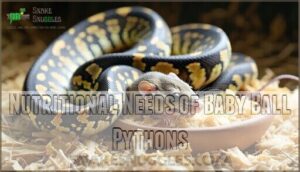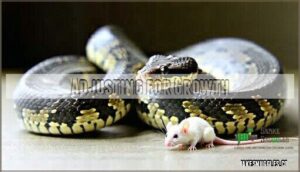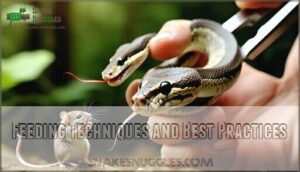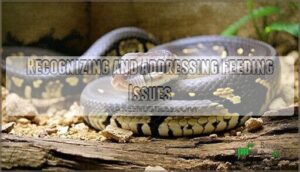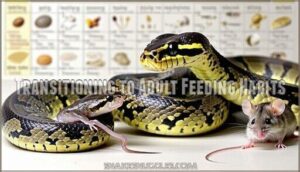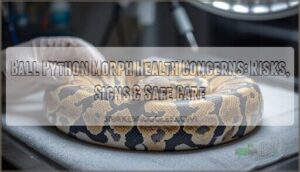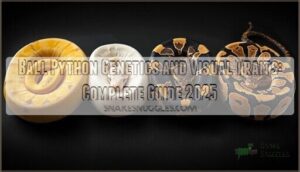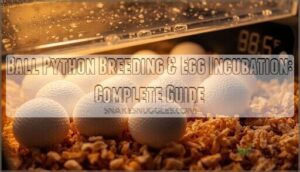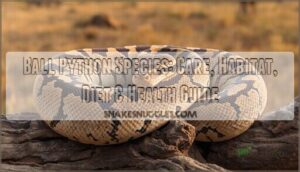This site is supported by our readers. We may earn a commission, at no cost to you, if you purchase through links.
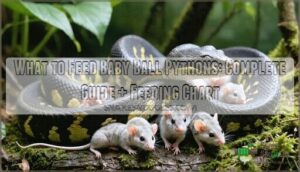
Size matters more than variety – the prey should be roughly as wide as your snake’s thickest part.
Skip live feeding; it’s risky business that can injure your python.
Frozen prey is safer, more convenient, and nutritionally identical.
Thaw the mouse completely, warm it slightly, and use feeding tongs to offer it.
Your little serpent doesn’t need supplements when eating whole prey, and getting the feeding schedule right from day one prevents picky eating habits later, which is a result of good feeding schedule.
Table Of Contents
- Key Takeaways
- What to Feed Baby Ball Pythons?
- Nutritional Needs of Baby Ball Pythons
- Ideal Prey Options for Baby Ball Pythons
- Frozen Vs. Live Prey Debate
- Preparing Frozen Prey for Baby Ball Pythons
- Feeding Frequency for Baby Ball Pythons
- Feeding Techniques and Best Practices
- Supplements and Vitamins for Baby Ball Pythons
- Recognizing and Addressing Feeding Issues
- Transitioning to Adult Feeding Habits
- Frequently Asked Questions (FAQs)
- What should I feed a baby ball python?
- What can baby ball pythons eat besides mice?
- What do newly hatched ball pythons eat?
- What do python babies eat?
- Can baby ball pythons eat insects?
- How to transition baby to frozen food?
- What to do if prey is rejected?
- Are there safe reptile-specific foods?
- Can baby ball pythons drink milk?
- How long after shedding should I feed?
- Conclusion
Key Takeaways
- You’ll feed your baby ball python frozen-thawed mice, starting with pinkie mice for hatchlings and moving to larger prey as they grow, ensuring they get the nutrients they need.
- It’s crucial to choose prey that’s the right size – about as wide as your snake’s thickest part – to prevent choking hazards and ensure proper digestion.
- You shouldn’t feed your baby ball python live prey, as it can be risky and cause injury, and instead opt for frozen-thawed prey, which is safer and more convenient.
- As your baby ball python grows, you’ll need to adjust their feeding schedule, increasing prey size and reducing feeding frequency, to support their development and prevent overfeeding.
What to Feed Baby Ball Pythons?
When your baby ball python arrives home, you’ll need to establish the right baby ball python food routine immediately. Pinky mice form the foundation of what baby pythons eat, providing complete nutrition in perfectly sized packages.
Creating the perfect feeding routine from day one sets your baby ball python up for lifelong health and happiness.
These frozen-thawed rodents should measure no more than 1.5 times your snake’s widest body section to prevent choking hazards.
Your baby python diet requires whole prey every five to seven days during the critical growth phase. Use feeding tongs to safely present thawed prey, avoiding live feeding dangers like bites and scratches.
A reliable pinky mouse source guarantees consistent meals, while proper prey gut-loading maximizes nutritional value.
Your hatchling’s first meal sets the feeding pattern, so patience matters if refusal occurs. Ball python feeding success depends on proper prey size, temperature, and timing for ideal development.
Nutritional Needs of Baby Ball Pythons
Your baby ball python needs whole prey items that provide complete nutrition, including essential proteins, vitamins, and minerals that support healthy growth.
You’ll want to select prey that’s appropriately sized, measuring 1 to 1.25 times your snake’s mid-body diameter, to guarantee proper digestion and prevent feeding complications.
Importance of Whole Prey
When you’re choosing baby ball python food, whole prey delivers everything your snake needs in one complete package.
Think of it as nature’s perfect meal – rodent prey contains the ideal balanced diet with nutrient completeness that processed foods can’t match.
Bone consumption provides calcium for strong skeletal development, while organ benefits supply vitamins A, D, and B-complex that support immune function and growth.
The liver, heart, and kidneys pack concentrated nutrition your baby python’s body craves.
Feeding whole prey also satisfies your snake’s natural instincts.
When you watch your python strike and constrict, you’re witnessing behaviors that keep them mentally sharp and physically healthy.
What do baby pythons eat in the wild? Complete animals – not vitamin-dusted fragments.
Whole prey mimics this natural diet perfectly, ensuring your growing snake gets balanced nutrition without guesswork or supplements.
Prey Size Guidelines
The proper portions for your baby ball python depend on finding the sweet spot between too small and too large.
Prey width should match your snake’s thickest body ratio – typically 1 to 1.25 times the diameter at mid-body.
What do baby pythons eat starts with pinky mice for hatchlings, then progresses to fuzzy rats as they grow.
Prey size matters more than you’d think.
Too small won’t satisfy their nutritional needs, while oversized meals can cause regurgitation or injury.
Aim for consistent size within the proper range, then plan for gradual increase as your python matures.
This feeding guide approach guarantees healthy growth without overwhelming their digestive system.
Remember, it’s better to err slightly smaller than risk complications.
Hatchlings typically consume hopper mice initially.
Ideal Prey Options for Baby Ball Pythons
You’ll find that mice provide the most suitable and nutritionally complete prey for your baby ball python, with pinky mice being the perfect starting size for newly hatched snakes.
While rats become a better choice as your python grows larger, baby ball pythons thrive on appropriately sized frozen-thawed mice that match their current body width, making frozen-thawed mice a key part of their diet.
Mice Varieties
When feeding ball pythons, understanding mice varieties makes all the difference in your baby’s growth and health.
Pinky mice are your starting point for hatchlings—these newborn, hairless rodents offer easy digestion for tiny snakes.
As your python grows, you’ll graduate to fuzzy mice, which sport light fur but remain manageable in size.
Hopper mice come next for older juveniles, providing more substantial nutrition as they’re mobile and larger.
Weaned mice bridge the gap before moving to adult mice for mature juveniles.
Each stage corresponds to your snake’s increasing girth and appetite.
Live prey carries risks, so consider the source carefully.
This progression guarantees proper ball python care while matching natural prey sizes that wild pythons would encounter.
Other Suitable Prey
While pinky mice form the foundation of your baby ball python’s diet, alternative rodents can provide valuable nutritional variety.
Gerbils offer a leaner protein profile compared to standard mice, while small hamsters provide different fat content ratios.
These options work particularly well for picky eaters who’ve grown bored with their usual meals.
Chicks and quail represent excellent occasional alternatives, especially day-old chicks that match your snake’s girth requirements.
However, these should remain supplementary rather than primary food sources.
Consider these alternative feeding strategies:
- Scenting techniques – Rub frozen prey with alternative rodents to encourage acceptance
- Last resort prey – Small gerbils work when your snake refuses everything else
- Nutritional variety – Rotating between mice, small rats, and occasional chicks prevents dietary monotony
Large crickets aren’t suitable for baby ball pythons due to inadequate nutrition and potential impaction risks.
It’s important to select prey that’s appropriately sized to avoid overfeeding.
Frozen Vs. Live Prey Debate
You’ll face an important decision when choosing between frozen-thawed and live prey for your baby ball python.
Both options provide complete nutrition, but they differ substantially in safety risks, storage convenience, and feeding requirements.
Safety Considerations
Snake bites aren’t just horror movie material—they’re real risks when feeding baby ball pythons.
Frozen prey eliminates most feeding dangers you’ll face.
Live rodents can scratch, bite, or stress your python, leading to prey injury for both animals.
Handling risks disappear when you use feeding tongs instead of bare hands for bite avoidance.
| Safety Factor | Live Prey Risk | Frozen Prey Benefit |
|---|---|---|
| Parasite Prevention | High transmission risk | Eliminates parasites completely |
| Regurgitation Hazards | Stress-induced vomiting | Calm, predictable feeding |
| Physical Injury | Scratches and bites | No aggressive behavior |
| Python Feeding Safety | Requires constant supervision |
Safe, hands-off approach.
Python food preparation with frozen pinky mice guarantees your baby ball pythons eat safely every time.
Nutritional Differences
Beyond safety concerns, you’ll find significant nutritional differences between frozen and live prey that directly impact your baby ball python’s development.
Both options provide complete nutrition, but frozen prey offers more consistent nutritional profiles since commercial breeding guarantees standardized rodent nutrition.
| Aspect | Frozen Prey | Live Prey |
|---|---|---|
| Prey Composition | Consistent nutritional content | Variable based on feeder condition |
| Wild vs Captive | Commercially bred standardization | Natural hunting simulation |
| Gender Differences | No impact on nutritional value | Stress may affect male pythons more |
| Age Variation | Same nutrition regardless of python age | Natural feeding behaviors encouraged |
| Rodent Nutrition | Controlled diet guarantees quality | Depends on feeder’s recent meals |
Frozen pinky mice and fuzzy rats maintain their nutritional value when properly stored.
Live prey’s nutritional content varies based on what the rodent recently ate.
To guarantee your snake receives all the necessary vitamins and minerals, lightly dust prey with a calcium and multivitamin mix occasionally.
For consistent python growth, frozen prey eliminates guesswork while supporting healthy development in baby ball pythons.
Preparing Frozen Prey for Baby Ball Pythons
Proper preparation of frozen prey guarantees your baby ball python receives safe, nutritious meals that encourage natural feeding behaviors.
You’ll need to completely thaw the rodent in your refrigerator, then warm it to 100-105°F using warm water to mimic the body temperature of live prey.
Thawing Methods
Once you’ve chosen frozen thawed mice for your baby ball python, proper thawing becomes your next priority. Refrigerator thawing offers the safest approach—simply move pinky mice from freezer to fridge overnight. This method prevents bacterial growth while maintaining nutritional integrity.
Need faster results? Try a water bath method by sealing the prey in a plastic bag and submerging it in cold water. Change the water every 30 minutes to maintain temperature control. Thawing duration varies by prey size, but pinky mice typically need 2-4 hours.
Many owners utilize a reptile thawing container to streamline this process.
Here’s a critical python feeding precaution: avoid microwaves completely. Microwave concerns include uneven heating, hot spots that can burn your snake’s mouth, and nutritional breakdown. These python feeding tips guarantee your frozen prey retains its quality and safety for your growing python.
Warming Techniques
Once your frozen thawed mice have properly thawed, warming them to the right python feeding temperature becomes your next priority.
Your hatchling ball python won’t show interest in cold prey – they’re programmed to detect warm-blooded meals.
Here’s your step-by-step warming process:
- Water bath method: Submerge pinky mice in 100-105°F water for 10-15 minutes, ensuring even heat distribution throughout the prey item.
- Hair dryer technique: Use low heat setting while moving the dryer constantly to avoid hot spots that could burn your snake’s mouth.
- Heat lamps: Position prey 6-8 inches below a ceramic heat emitter for gradual warming.
- Temperature monitoring: Always check with an infrared thermometer before feeding – prey should feel warm, not hot, to your touch.
Remember to take into account the snake’s appropriate girth when selecting prey size.
Feeding Frequency for Baby Ball Pythons
You’ll need to feed your baby ball python every 5-7 days to support their rapid growth and development during the first six months of life.
As your snake matures from juvenile to adult, you’ll gradually extend feeding intervals from weekly to every 2-3 weeks, adjusting the schedule based on their age, size, and individual growth rate.
Age-Based Schedules
Now that you’ve mastered thawing frozen prey, establishing the right python feeding schedule becomes your next priority.
Baby ball pythons require different feeding frequencies based on their developmental stage and growth needs.
Hatchling feeding occurs every 5-7 days since these tiny serpents burn through energy quickly. Juvenile frequency shifts to every 7-10 days as their metabolism stabilizes. Subadult intervals extend to 10-14 days when growth slows but nutritional demands remain high.
A key indicator is increased tongue flicking, which signals hunger.
Here’s your age-based feeding reference:
| Age Group | Feeding Interval | Prey Size |
|---|---|---|
| Hatchlings (0-6 months) | Every 5-7 days | Pinky mice |
| Juveniles (6-18 months) | Every 7-10 days | Fuzzy/hopper mice |
| Subadults (18+ months) | Every 10-14 days | Adult mice |
Monitor your snake’s body condition regularly. Adult schedules and breeding adjustments will come later as your python matures.
Adjusting for Growth
Your baby ball python’s feeding schedule and prey size must evolve as they reach different growth stages.
Weight monitoring weekly helps track healthy development and signals when adjustments are needed.
Once your snake reaches 1,500 grams, you can space feedings to every 4-6 weeks with larger prey items.
This python feeding guide approach supports their changing nutritional needs while preventing overfeeding.
Watch your snake’s body condition and appetite closely – these cues tell you when it’s time to modify food size and frequency for ideal health.
Feeding Techniques and Best Practices
You’ll need proper feeding techniques to guarantee your baby ball python eats safely and develops healthy feeding habits.
Using feeding tongs and establishing a consistent routine prevents stress, reduces bite risk, and helps your snake recognize feeding time.
Using Feeding Tongs
In regards to python feeding safety, feeding tongs create the perfect safe distance between you and your baby ball python.
These essential tools offer clear tongs advantages—they prevent accidental bites while protecting your snake from injury during feeding.
Grip the prey item by the tail using metal or plastic tongs, maintaining a proper grip throughout the process.
Gentle wiggling during prey presentation mimics natural movement, triggering your python’s hunting instincts.
Many keepers find it useful to buy specialized tongs for this purpose.
This technique masks your hand’s scent, reducing feeding-related stress.
Following these python feeding precautions and python feeding techniques guarantees successful meals while minimizing risks for both you and your snake.
Creating a Feeding Routine
Once you’ve mastered feeding tongs, establishing a consistent schedule becomes your next priority. Your baby ball pythons thrive on predictability, so feed them at the same time each week.
Choose a feeding location within their enclosure and stick to it – moving them elsewhere creates unnecessary stress and can trigger feeding refusal. Before offering pinky mice, use routine cues like gentle tapping on the enclosure to signal mealtime.
This helps separate feeding from handling sessions. Your feeding frequency should remain steady: every 5-7 days for juveniles under six months.
Keep detailed record keeping of dates, prey size, and your snake’s weight. Weekly weigh-ins reveal growth patterns and potential issues.
During winter months, make seasonal adjustments to your ball python diet as their metabolism naturally slows. This structured approach builds trust and reduces feeding anxiety.
Supplements and Vitamins for Baby Ball Pythons
You don’t need to add vitamins or supplements to your baby ball python’s diet when you’re feeding whole prey items like mice or rats.
These complete prey animals already contain all the nutrients, vitamins, and minerals your growing snake requires for healthy development.
When Supplements Are Necessary
Most baby ball pythons thrive on whole pinky mice without additional nutrition supplements. However, specific circumstances may warrant careful supplementation to prevent deficiency symptoms.
Consider supplements when you notice these warning signs:
- Stunted growth despite regular feeding schedules
- Irregular shedding patterns or retained shed pieces
- Lethargy or decreased appetite over extended periods
- Visible bone deformities or soft shell development
- Specific needs during rapid growth phases
Calcium and vitamin D3 represent common supplement types, but over-supplementation risks include organ damage. Always seek veterinary guidance before introducing supplements to guarantee your snake’s healthy well-being.
How to Apply Supplements
To provide supplements for baby ball pythons, choose reputable calcium and multivitamin powders. Lightly coat thawed prey by placing it in a plastic bag with the supplement and shaking gently.
Follow dosage guidelines closely to avoid over-supplementing, as excessive nutrients can harm your python.
Consider buying python supplies online for convenience. This method guarantees your snake receives the nutrients needed for healthy growth without disrupting its natural eating process.
Regularly check for signs of nutrient deficiencies, like lethargy or poor shedding, to adjust your feeding tips and maintain prime reptile nutrition.
Recognizing and Addressing Feeding Issues
You’ll encounter feeding challenges with your baby ball python at some point, whether it’s refusing prey, eating irregularly, or showing stress-related feeding behaviors.
Understanding common refusal reasons like incorrect temperatures, improper prey size, or environmental stress will help you identify problems quickly and implement effective solutions to get your young snake back on track, by addressing issues such as environmental stress.
Common Refusal Reasons
When your baby ball python turns its nose up at dinner, several factors could be behind this feeding refusal.
Stress tops the list – recent handling, enclosure changes, or environmental disturbances can trigger appetite loss.
Temperature issues often cause problems too; without proper thermal gradients, your snake won’t feel like eating.
Illness and parasites also suppress appetite, requiring veterinary attention if refusal persists.
Shedding naturally reduces hunger, so don’t worry if your python skips meals during this process.
Prey selection matters as well – some baby ball pythons prefer specific presentation methods or prey types.
Understanding these feeding challenges helps you identify what’s keeping your snake from eating and address the root cause effectively.
Encouraging Reluctant Eaters
When your baby ball pythons turn their nose up at dinner, don’t panic.
Start with prey selection – some prefer mice over rats or vice versa. Try scenting techniques like dipping prey in chicken broth or braining prey by exposing the skull contents to release stronger scents.
Make habitat adjustments by reducing noise and providing privacy during feeding time. Offer meals during evening hours when they’re naturally active.
If problems persist after trying different small snake food options and snake feeding tips, consider assist feeding or schedule a veterinary consult to rule out health issues affecting these reluctant eaters.
Transitioning to Adult Feeding Habits
You’ll need to gradually increase prey size and reduce feeding frequency as your ball python grows from juvenile to adult.
This shift typically begins around 12-18 months of age when your snake reaches approximately 500-700 grams and requires careful monitoring to guarantee proper nutrition without overfeeding.
When to Increase Prey Size
Growth milestones help determine when to upsize prey for your growing snake.
Weight monitoring shows you’ll need larger food when your ball python reaches 15-20% body weight increase.
Shedding cycles signal perfect timing for prey selection changes since snakes experience growth spurts afterward.
Watch their feeding response – increased appetite indicates readiness for bigger meals.
Check body condition regularly; proper snake growth requires matching food size to development.
Snake prey size should equal the widest part of their body.
Adjusting Feeding Frequency
Several factors influence when you’ll need to adjust your ball python’s feeding frequency as it matures from hatchling to adult.
Growth rate varies substantially between individual snakes, so you can’t rely on age alone. Monitor your snake’s weight weekly and track shedding cycles – rapid shedders often need more frequent meals.
Activity levels also provide clues about nutritional needs. Most hatchlings start eating every 5-7 days, then graduate to 10-14 days by their first birthday.
However, individual variation means some pythons mature faster than others. Adjust food size and snake feeding frequency based on your specific python’s development rather than following rigid schedules.
Frequently Asked Questions (FAQs)
What should I feed a baby ball python?
You should feed baby ball pythons appropriately sized pinky mice, gradually increasing prey size as they grow, ensuring proper nutritional intake for healthy development.
What can baby ball pythons eat besides mice?
You can offer baby ball pythons rats, but they’re usually too big, so tiny quail or chicks are occasional alternatives to mice, under close supervision.
What do newly hatched ball pythons eat?
You’ll typically feed newly hatched ball pythons small, appropriately sized pinky mice, providing essential nutrients for growth and development.
What do python babies eat?
You’ll feed python babies appropriately sized pinky mice, gradually increasing prey size as they grow, ensuring proper nutritional intake for healthy development.
Can baby ball pythons eat insects?
You shouldn’t feed baby ball pythons insects, as they require a diet of small rodents, like pinky mice, for proper nutrition and growth, ensuring a healthy start in life.
How to transition baby to frozen food?
You’ll switch your baby ball python to frozen food by starting with small, thawed prey items, like pinky mice.
And gradually increasing size as they grow and accept the new food.
What to do if prey is rejected?
Like a puzzle piece not fitting, if prey is rejected, try warming it or offering a different size or type to pique the baby ball python’s interest, don’t force it.
Are there safe reptile-specific foods?
You can feed baby ball pythons commercially reared rodents, such as mice or rats, which provide complete nutrition and are considered safe reptile-specific foods.
Can baby ball pythons drink milk?
You shouldn’t give baby ball pythons milk, as they’re obligate carnivores, requiring whole prey items like mice or rats for complete nutrition, not dairy products.
How long after shedding should I feed?
You should wait until your ball python has fully recovered from shedding, usually a few days, before feeding to prevent stress and regurgitation.
Conclusion
You’ll find that 90% of ball python owners prefer frozen-thawed prey.
Regarding what to feed baby ball pythons, remember size matters, and frozen prey is safer.
You’re now equipped to provide the best diet for your pet, so go ahead and feed your baby ball python with confidence, mastering what to feed baby ball pythons.
- https://paymentportal.achievers.edu.ng/default.aspx/virtual-library/00034/TheBallPythonHerpetoculturalLibrary.pdf
- https://www.rspca.org.uk/adviceandwelfare/pets/other/royalpython
- https://www.quora.com/Im-having-difficulty-feeding-my-ball-python-Do-you-have-any-tips
- https://www.petco.com/content/content-hub/home/articlePages/caresheets/ball-python.html
- https://onlinelibrary.wiley.com/doi/10.1111/j.1439-0396.2010.01011.x

